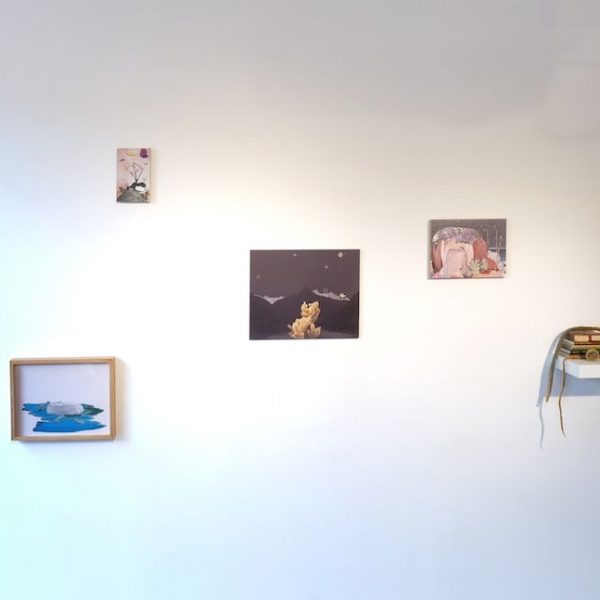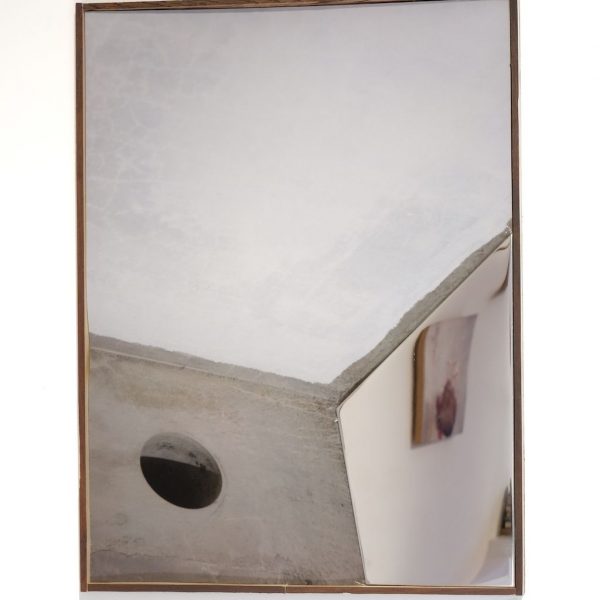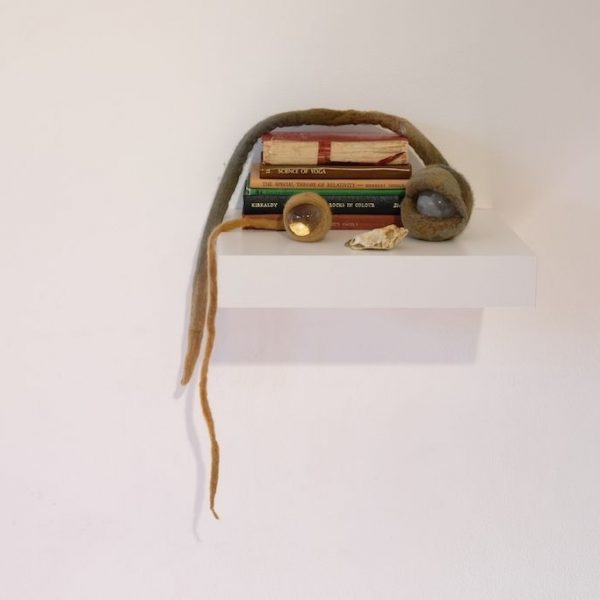
TEXT BY 撰文 x LI BOWEN 李博文
IMAGES COURTESY OF 圖片 x SUN SHI 孫詩
“It is the same – threefold – Psyche, a woman, and each time there is a reminder, as Freud puts it, that she is extended (asugedehnt). But each time (and three times the first sentence resonates in French, “Psyche est étendue…” [“Psyche is extended…”]) the mise-en-scène differs, as do the tableau and the implicit narrative.”
– On Touching, Jean-Luc Nancy, Jacques Derrida
“ 這 是 同 一 個 —— 三 層 —— 心 靈[ P s y c h e ,普 塞 克 ],一 個 女 人 ,以 及 每 一 次 的 提 醒 ,就 如 弗 洛 伊 德 所 說 的 ,她 是 被 延 伸 的 。但 每 一 次( 而 第 一 句 在 法 語 中回響了三次,”Psyche est étendue…”)“[ 普塞克是被延伸的…”])場景 都有所改變,畫面及隱含的敘事也有所改變。”
——《論觸摸—讓-盧克·南希》,雅克·德理達
Three is perhaps always better than four, especially for Chinese. But bearing in mind my previous writing with Sun Shi, Alice Serraino and Giovanna Petrocchi, it is clear that from the beginning, when nature or pseudo-natural subject/object was chiefly concerned, the divinity and beauty of tri- was damaged. I was the fourth member, as exterior as I was to their practices that were viewed and treated provisionally as one. And I was a man.
Diego Valente is, I assume, a man as well. Not only have I yet met him, but one’s gender should really be questioned, solemnly or playfully. Exhibiting with three women – as I wanted to have one male Chinese artist included in an exhibition with four other women – could this act of exhibiting (in all sense of the word) be transformative? Could his work through a certain act of mutual penetration – again, penetration, again, touching, again, nature, again, Psyche, for this is a conclusion, introspective and retrospective in nature, of a good party of three and good three years of memory city of London – be transformed, as did the works of Sun Shi, Alice and Giovana and mine?
Just as I was on the previous occasion, I am still the absent male, not able to be there and witness the exhibition with my own eyes. It seems that my absence is imperative for the event to happen. Though I did see more of the exhibition then. But again I would like to stubbornly resist privileging the act of seeing, still I would like to try out the belief that being there – being, being present, in this context always means seeing – is not of cardinal import. Being there, seeing the exhibition is not as important as probing it, feeling it with hands, from a distance, in dark, because (if a reason is really called for here): how can one simply see a Psyche? Isn’t seeing the Psyche an illusory idea? In-stead of seeing, we are led to believe that we ought to touch (by negating touching) it.
“Psyche ist ausgedehnt, weiss nichts davon.” -- Sigmund Freud
“普賽克在延伸,不知道這回事。”——弗洛伊德
Sun Shi is not quite remembered as the woman laid up on her bed. Just as we cannot be quite certain about valuations of the Psyche (who can?), Sun Shi is deliberately made uncertain, vague and sophisticated. Sun Shi narrates in three years’ time firstly a departure from playing with her own body – veiled and mirrored – in Deformity (2013), in a domestic environment. When photography was still to a larger extent photography proper (Philip-Lorca diCorcia, American artist, is out there somewhere trying not to smile), Sun Shi in a way extended herself and put herself both in front of and behind the camera, alluding to a certain illusive nature of pornographic photography: elusion, refusing being captured or touched – at least not fully – reluctant about being in contact with the viewer’s gaze, and refusing, perhaps we can venture and argue, a certain phantom limb of the viewer.
Sun starting with the body seemed to be justified. Not only because she was a woman, I will have to say, but she was also Chinese. Our bodies, mine and hers, and even yours, could remain mysterious to us for as long as we are exposed to Sun. I am however not claiming that it is cultural, this not-knowing-enough of one’s body, or in other words not having the body exhausted by one’s mind; hopelessly being Chinese here is still considered an excuse for, simply, not being British or Continental: “Psyche ist ausgedehnt, weiss nichts davon.”
Then, rather soon(tôt), she moved to the corner in Space in Between (2013-2014). Literally, her presence is moved to the margin of her photograph, championing instead corner found in indoor environments. It was obvious then that she cannot be hidden from her body or her knowledge for-ever. In relation to classical ideas of sculpture and painting, it was discovered that photographs are by contrast space-less. “I want to create a space for a photograph, to question and challenge the flatness of photography, to create an awareness of the space.” By working on and in the margin, therefore, Sun made a turn that was both spatial and, one is tempted to say, linguistic. From a play with bodily representations, this never-static Sun moved (but what moved her?) to a conceptual investigation into the spatial nature of photography as a genre – or the lack of it – that seemed then natural and inspired. After all, successfully Sun was initiated into the art discourse of UK, ontologized(if it is possible at all), alienated and indeed removed. After solving her problematic body, as a being proper – however provisional she could remain in this condition – she started noticing the world as she never had, paradoxically and ironically rendering herself absent. That is, after seeing, after addressing, noticing, taking note of herself, she began to speak. “Now, although the mouth is touching…, it is also detaching itself from the breast. It interrupts the contact in order to speak-think, in a first opening, an initial and original spacing: “And there, what comes to pass is that [the ego] spaces itself out…’Spacing brings about the free, the open, [the spacious,] for man’s settlement and dwelling’…But man is that which spaces itself out and never dwells elsewhere, perhaps, but in this spacing, in the reality of the mouth”.”
“Psyche is extended in the shade of a walnut tree, as the daylight fades. She lies at rest; the slight movements of sleep have half exposed her bosom. Flustered and mischievous, all at once, Eros contemplates her. Psyche knows nothing of this. Her sleep is so deep that it has even robbed her of any abandon in her pose.”
For a rather long period, Sun has also been stalked. Following, chasing, keeping contact her stalker has not been extremely motivated as to see her, but has been determinately touching and penetrating her (Psyche), with her words – Erotic words, words that come from the mouth of Eros. And, naturally, as civil as Sun is, she reads without replying. Perhaps now and only now can we start to consider valuations of Psyche. It extends, by spacing itself out, by playing in and of herself an emergence, a coming to foreground, to forehead, to the fore – but even now, or even soon, in the future, it will not be disclosed to her, and a touch has to be as speculative as can be.
Psyche is extended in her coffin. Soon it is going to be shut. Among those present, some are hiding their faces, others are keeping their eyes desperately fixed on Psyche’s body. She knows nothing of this – and that is what everyone knows around her, with such exact and cruel knowledge. – Derrida
數字“三”應當永遠比“四”要好,尤其是對於中國人來說。然而,很明顯的是,從最初,從我為孫詩、Alice以及Giovanna的首個以某種特殊的自然為主題(或貌似自然的主題/客體)的合作展覽計劃進行寫作開始,“三”的神聖性或美麗早已被損毀。我是不應當在場的第四個成員,我是三位一體(我們最終得到這樣的結論:三人於合作計劃中進行的藝術實踐可以也應當被暫時地視作是同一個藝術實踐)外部的第四位成員。而且我是一個男人。
Diego,我想,也是一個男人。我不僅從未見過他,我們也應當在此強硬、嚴肅而輕易地質詢他的性別及其意義。他與三個女人一起進行展覽——就像我曾希望策劃一次有著一名男性藝術家以及四名女性藝術家的展覽一樣:基本而顯性的性別傾向——這種展覽(exhibiting,同時也有展示,暴露等解釋)能否帶來某種特殊而奇異的轉換?他的作品能否通過一種相互的穿透——再次地,穿透,再次地,觸摸,再次地,自然,再次地,普賽克(Psyche,在古希臘語中意為心靈),因為,無論如何,這是一個關於三人及三年時間的內省的、回顧式的結論——被轉化,就像孫詩、Alice以及Giovana以及我的作品曾經遭遇的那樣?
如過往一樣,我仍然是那個不可見的、缺席的男人,不能夠親自前去參觀展覽。這樣一來,我的缺席幾乎成為了展覽一事的必要條件。儘管在過去我曾經見到過更多的作品。然而,我仍然固執地希望可以拒絕觀看,我仍然希望嘗試著一個信仰:在我們所在的語境中意味著觀看的存在、在場,並不是無比重要的。在場,看展覽,並不如在某種距離之外、在黑暗中穿透、用手去觸摸,因為(如果我們的確需要一個理由的話):我們要怎樣去看心靈(普賽克)?去看心靈(普賽克),難道不是一個愚蠢的主意嗎?我們被說服,我們應當(通過抹殺觸摸去)觸摸這心靈(普賽克)。
孫詩留給人的印象並不是那個躺在床上或樹下的女人。就像我們不能確實地討論心靈(普賽克)一樣(誰又能夠確實地討論這普賽克呢?),孫詩也不自覺地變得不確定,模糊而復雜。在三年的時間內,孫詩首先在2013年作品《Deformity》中敘述了從身體——被掩蓋或反射的身體——中的逃脫。在攝影藝術仍然是攝影藝術的時候(美國藝術家Philip-Lorca di-Corcia強忍著不要笑出聲來),在這個安靜而奇異的室內環境中,孫詩延伸了自身,將自身置於鏡頭前及鏡頭後,並暗指向某種處於情色攝影核心的特性:躲閃,拒絕被觸摸所捕捉,也因觸摸到觀者的目光(或幻肢)而猶豫。
從身體開始創作,似乎是理所當然的。孫詩不僅是一個女人,還是來自中國的女人。我們的身體,我的身體,她的身體,甚至是你的身體,都在太陽之下以陰影遮掩自身。我並不想在此宣布這種對自身身體的無知——或,換句話來說,借心靈(普賽克)以耗盡自己的身體——是文化狀況(而我也贊美這種無知);然而,中國身份在這裡仍然要被當作是不能夠以英國或歐洲大陸的方式思考自身的理由:“Psyche ist ausgedehnt, weiss nichts davon.”
繼而,快速地(tôt),孫詩通過在2013年至2014年完成的作品《Space in Between》逃離至角落之中去。她的存在轉移至照片的邊緣之外,而將自己的目光轉移至室內空間的角落之上。顯然的是,她不能永遠地逃脫自身身體或知識的控制。在與經典繪畫及雕塑的定義進行對比時,她意識到,攝影是沒有空間的。“我想要為攝影創造一個空間,去質問並挑戰攝影的平面性,去創造一個空間的意識。”通過在邊緣之中(及之上)創作,不停歇的孫詩從身體的再現移向(然而,這是什麼樣的一種移動?)轉而在概念上探索作為一種藝術形式的攝影的空間特性——而這個轉向貌似是自然的,受影響的。無論如何,孫詩成功地進入了英國的藝術話語之中,本體化自身(如果這是可能的話),被異化,被剝離。在解決了自身身體的問題之後,作為一個正當的存在——無論這是一個多麼臨時的狀況——她開始以嶄新的方式重新發現世界,矛盾地、諷刺地在這個過程中隱去自身。也就是說,在看見、關注、發現並記錄自身之後,她開始言說。“這時,儘管嘴在觸碰…這嘴已離開了乳房。它打斷了那接觸以進行說話-思考,在第一開闔之中,一種初步而原初的空間創造:“在那裡,經過的是[自我]創造空間的過程…’創造空間帶來自由的、開放的、[空曠的]事物,以供人定居生活’…但人是那為自身創造空間的存在,也從來不生活於別處,可能,只生活於這創造出的空間之中,在嘴的現實之中。””
“在太陽落下之時,普賽克在胡桃樹的陰影中延伸自身,她在休息;睡眠帶來的輕微動態將她的乳房半裸露出來。同時慌張而頑皮的愛神在注視、打量著她。普賽克完全不知道這件事。她睡得那麼沈,她根本不能改變自己的姿勢。”
在很長的一段時間裏,孫詩被跟蹤。她的跟蹤者跟隨、追趕,與她保持關係,然而並不致力於看見她,而是決絕地用她的文字觸摸或貫穿她(的心靈[普賽克])——愛神的文字,來自愛神之口的文字。自然地,孫詩禮貌地閱讀而不回覆。可能只有在這個時候我們才能夠期待開始評估、測量心靈(普賽克)。這心靈(普賽克)延伸,為自身創造空間/將自身消除,玩弄作為展現、進入前景之物——但,就算是在現在,或很快,在未來,她不將意識到這件事,而觸摸將是虛無縹緲的。
“普賽克在她的棺木中被延伸。很快這棺木就會被封上。在在場的人之中,有一些在以手掩面,有一些則絕望地盯著普賽克的身體。她不知道這些事——而這就是所有在旁的、有著精確而殘忍的知識的人都知道的。”——德裏達




























